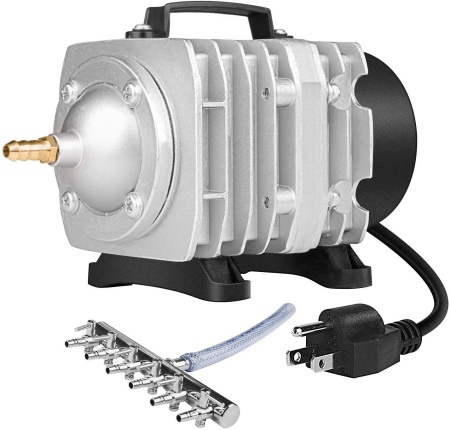| Back to Back Issues Page |
 |
|
The Goldfish Gazette, Issue #080 Air Pumps August 31, 2020 |
Goldfish Care TipsA Free Monthly Resource For Goldfish Enthusiasts In This Issue Bubbles add ambience to any aquarium, but the air pumps or aerators that produce the bubbles do have their issues. Air Pumps (Aerators)
Is Aeration of the Aquarium Water Necessary?Apart from adding atmosphere and interest to an aquarium, bubbles help circulate the water, bringing it to the surface so assisting the exchange of carbon dioxide for oxygen.Filters do the same thing. If you have a power filter, you don’t also need air bubbles. Types of AeratorsThe vast majority of aerators on the market use synthetic rubber diaphragms actuated by an electromagnetic coil.This design creates vibration and noise as the lever attached to the diaphragm moves backwards and forwards at high speed. These are two serious problems with all types of aerators on the market. The first claim made by manufacturers is usually that their product is “whisper” quiet, and indeed some are. However, after some use, even the quiet ones become noisier. Vibration is the bigger problem with aerators as some tend to creep on any hard surface they are placed on. If they contact another object, wear quickly occurs on the body of the aerator, and the other object. Some aerators come with sucker discs so they can be stuck to a smooth surface. A recent development is some manufacturers are using a piezoelectric ceramic plate instead of a rubber diaphragm which is claimed to be quieter in operation, but again, after a period of use these also become noisier. Electromagnetic piston pumps (above), as the name suggests use a piston that oscillates back and forth to create air pressure. These pumps are used in the medical industry because of their reliability, but…they are very noisy. I use several of these pumps because I am running aquariums and ponds with sponge filters, but the pumps are in a garage away from the house. They couldn’t be used inside a house unless placed in a sound proof container, but as these pumps run very hot, I wouldn’t be happy with them in an enclosed space. Installing an AeratorThere are several criteria you need to consider before purchasing any aerator.Many manufacturers suggest the aquarium size the aerator is made for, but this is misleading. The more important factor is water depth. The deeper the water, the higher the pressure required to run air stones and filters. Air stones usually require higher air pressure than other types of air diffusers. They also tend to clog over time. I use adjustable plastic diffusers for these reasons. Placement of the aerator should ideally be above the water level of the aquarium, but this isn’t always possible. If it isn’t possible, you must loop the air line above the water level, and fit a non-return valve. It is truly amazing how fast water will start siphoning out of an aquarium if the aerator is turned off or there is a power cut. As each bubble rises to the surface and bursts, it creates a micro splash. As thousands of these micro splashes gather on the aquarium cover, they cause drips to form. If these drips can’t drop back into the aquarium because the aquarium isn’t level or the cover overhangs, they can run down the sides of the aquarium causing damage to furniture or flooring. Never clamp an aerator if it produces too much air, always bleed the excess air off. By clamping off the airline, it puts pressure on the internal workings of the aerator, causing early failure. SummaryI am not recommending any particular brand of pump as there are always ecstatic as well as disappointed customers with every brand. I would suggest purchasing from Amazon.Com, or at least comparing brands on their site by reading real customer reviews.As I always suggest with filters, purchase an air pump at least twice the size recommended for your aquarium, as output decreases with age. Read the claimed air output, usually expressed in liters per minute/hour, and the decibel level. The link below is to a website that tested over 60 aerators; well worth a read if you are in the market for one. https://fishlab.com/aquarium-air-pump/
Comments? Ideas? Feedback? I'd love to hear from you. Just reply to this e-zine and tell me what you think, or what topics you want covered. Next Month's Topic Treating Injurieswww.facebook.com/aboutgoldfish |
| Back to Back Issues Page |